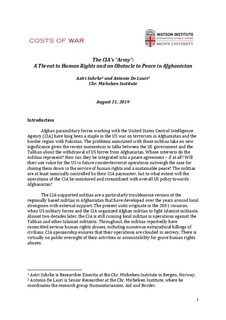The “CIA’s Army”: A Threat to Human Rights and an Obstacle to Peace in Afghanistan
Research report
Permanent lenke
http://hdl.handle.net/11250/2609873Utgivelsesdato
2019-08-01Metadata
Vis full innførselSamlinger
- Publications [1488]
Originalversjon
Providence: The Watson Institute for International and Public Affairs, Brown University (Costs of War) 14 p.Sammendrag
Afghan paramilitary forces working with the United States Central Intelligence Agency (CIA) have long been a staple in the US war on terrorism in Afghanistan and the border region with Pakistan. The problems associated with these militias take on new significance given the recent momentum in talks between the US government and the Taliban about the withdrawal of US forces from Afghanistan. Whose interests do the militias represent? How can they be integrated into a peace agreement – if at all? Will their use value for the US in future counterterrorist operations outweigh the case for closing them down in the service of human rights and a sustainable peace? The CIA-supported militias are a particularly troublesome version of the regionally based militias in Afghanistan that have developed over the years around local strongmen with external support. The present units originate in the 2001 invasion, when US military forces and the CIA organized Afghan militias to fight Islamist militants. Almost two decades later, the CIA is still running local militias in operations against the Taliban and other Islamist militants. Throughout, the militias reportedly have committed serious human rights abuses, including numerous extrajudicial killings of civilians. CIA sponsorship ensures that their operations are clouded in secrecy. There is virtually no public oversight of their activities or accountability for grave human rights abuses. This Report was published by the Watson Institute for International and Public Affairs , Brown University , as part of their Costs of War project and report series. Read the full text here Read the article in the Intercept based on the report: Taliban Peace Talks must not ignore CIA-funded Afghan Militias, report says
Utgiver
The Watson Institute for International and Public Affairs, Brown UniversitySerie
Costs of WarCosts of War
Costs of War
Costs of War
